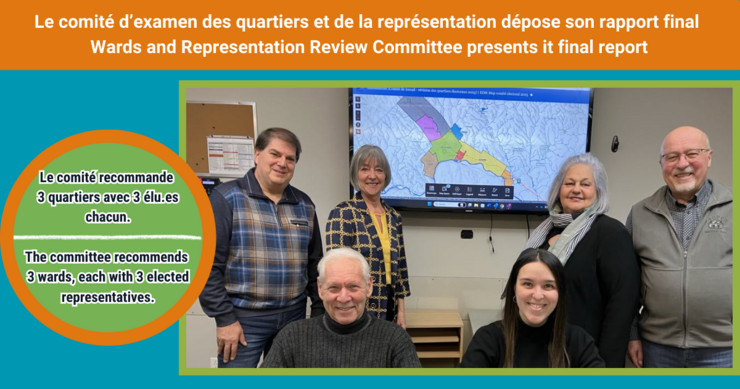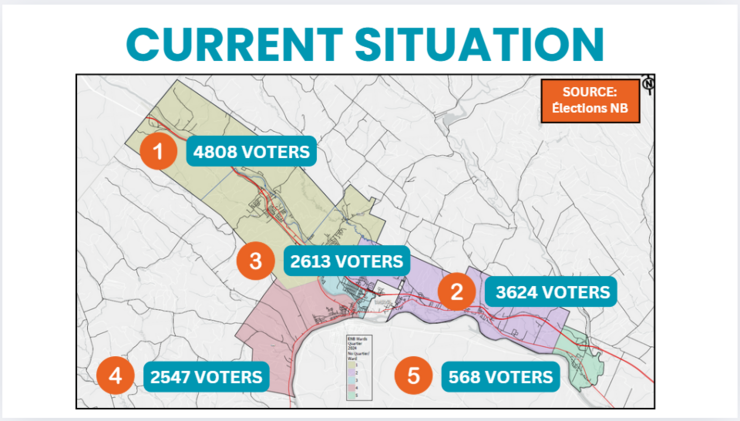Review of wards and modes of representation

After an intense period of consultation, with public sessions, an online survey and meetings with various experts, the citizens' committee responsible for reviewing electoral wards and modes of representation presented its final report to the municipal council at its monthly public meeting.
In addition to gathering and analysing comments from the public, the review committee carried out the complex task of analysing data and best practices. The committee's formal recommendation is to divide the new municipal territory into three electoral wards, each represented by three councillors.
The complete report in French can be viewed and downloaded by CLICKING HERE.
According to the committee's chairman, retired judge George Pérusse, this new approach is dynamic, forward-looking and progressive. "We believe it represents an effective, fair and collaborative model, and encourages partnership with rural and urban communities. It instils a sense of trust, pride and belonging across the new territory," he told the council members.
The committee examined various representation models, the number of wards and the ideal number of councillors to arrive at its recommendation. The recommended model of 3 wards is divided geographically along the three main axes of the municipality and combines wards 2 and 5, and wards 4 and 3. Ward 1 remains in its entirety.
"By proposing this change, we are close to parity in the number of electors per ward, as specified by case law, i.e. Ward 1 with 4,808 electors, Ward 2 with 4,192 electors and Ward 3 with 5,160 electors. There is also a geographical balance and equity of power between the wards," explained Mr Pérusse.
The committee held public consultation sessions in each ward from February 10 to 25. From February 25 to March 7, the committee made an online survey available to residents to find out their views on the various models under study. In all, 77 people took part in the neighbourhood meetings and 145 people completed the survey. The committee also consulted experts and reviewed relevant documentation from Canadian municipalities.
City Council will now deliberate on the final report and is expected to amend the municipal by-law by the end of the summer. The by-law must then be approved by the provincial government in the fall and put in place for the 2026 municipal elections.
review committee on electoral WARDs and representation methods
Due to the Local Governance Reform of 2023, which saw the amalgamation of the City of Edmundston, the Village of Rivière-Verte, part of the LSD of Saint-Jacques and part of the LSD of Saint-Joseph, the municipal council has asked to review the boundaries of the electoral wards and the representation methods and to suggest a method of representation based on comments received during consultations with the public.
In particular, Edmundston's elected officials want to find a citizen representation model that reflects this new municipal entity.
In order to proceed with this complex process, the municipal council approved in December 2024 the creation of an independent advisory committee of citizens whose mandate includes examining and recommending models for representing the population.
The aim of this review of electoral arrangements is to help ensure effective and equitable representation, thereby giving the communities that make up this new City a voice in the decision-making process. In particular, the review could realign boundaries, reflect demographic changes and better serve the distribution and evolving interests of communities.
Retired judge George Pérusse has agreed to chair the Ward and Representation Review Committee. He is assisted by the following members:
- Dominique Babineau
- Jacques Desjardins
- Madeleine Dubé
- Bernard LeBel
- Noëlline LeBel
UPDATE - FINAL REPORT PRESENTED IN aPRIL
After an intense period of public consultation, with public sessions, an online survey and meetings with various experts, the citizen committee responsible for the review of electoral wards and representation methods is now analyzing the data and best practices in this complex process.
Public consultation sessions were organized by the review committee in each ward from February 10th to the 25th. From February 25th to March 7th, the committee made an online survey available to the public to find out their views on the various models under consideration. A total of 77 people took part in the neighbourhood meetings and 145 people completed the survey.
The survey focused on the following issues:
- The current traditional model (ward-based representation)
- The general representation model (no wards, with councillors elected by the population for the entire territory)
- The hybrid representation model (with wards, where some councillors are elected by the population as a whole and others by ward).
- The number of wards needed to represent the population properly
- The ideal number of councillors
George Pérusse, chair of the review committee, says that the meetings with the public have led to frank discussions on the current operation of the representation wards, especially since the municipal reform of 2023, when parts of the LSDs of Saint-Jacques and Saint-Joseph as well as the Village of Rivière-Verte joined the City of Edmundston. "It is largely thanks to our discussions with the public and the survey responses that we will be able to make recommendations to the municipal council," explained Mr Pérusse.
The review committee began its work in early January. Members developed a work plan, a consultation plan and a communications plan, and reviewed the requirements of the Local Governance Act, the Elections Act, the White Paper on Local Governance in New Brunswick, and applicable Canadian case law. The group also held discussions with various stakeholders, including a political scientist, an urban planner, a geomatics specialist, a geographer and New Brunswick municipal administrators.
The review panel is currently analyzing the information and data gathered to date to formulate a recommendation on the desirable representation model for the 2026 municipal election as mandated. A final report is to be presented at the public meeting of City Council on April 15, 2025, at the Edmundston Arts Centre.
CLICK HERE TO VIEW THE PRESENTATION MADE DURING THE PUBLIC CONSULTATION SESSIONS




